
Rohingya: Golden History of Arakan (Rohingya) Muslims
-
News Articles
- at 12 September 2017
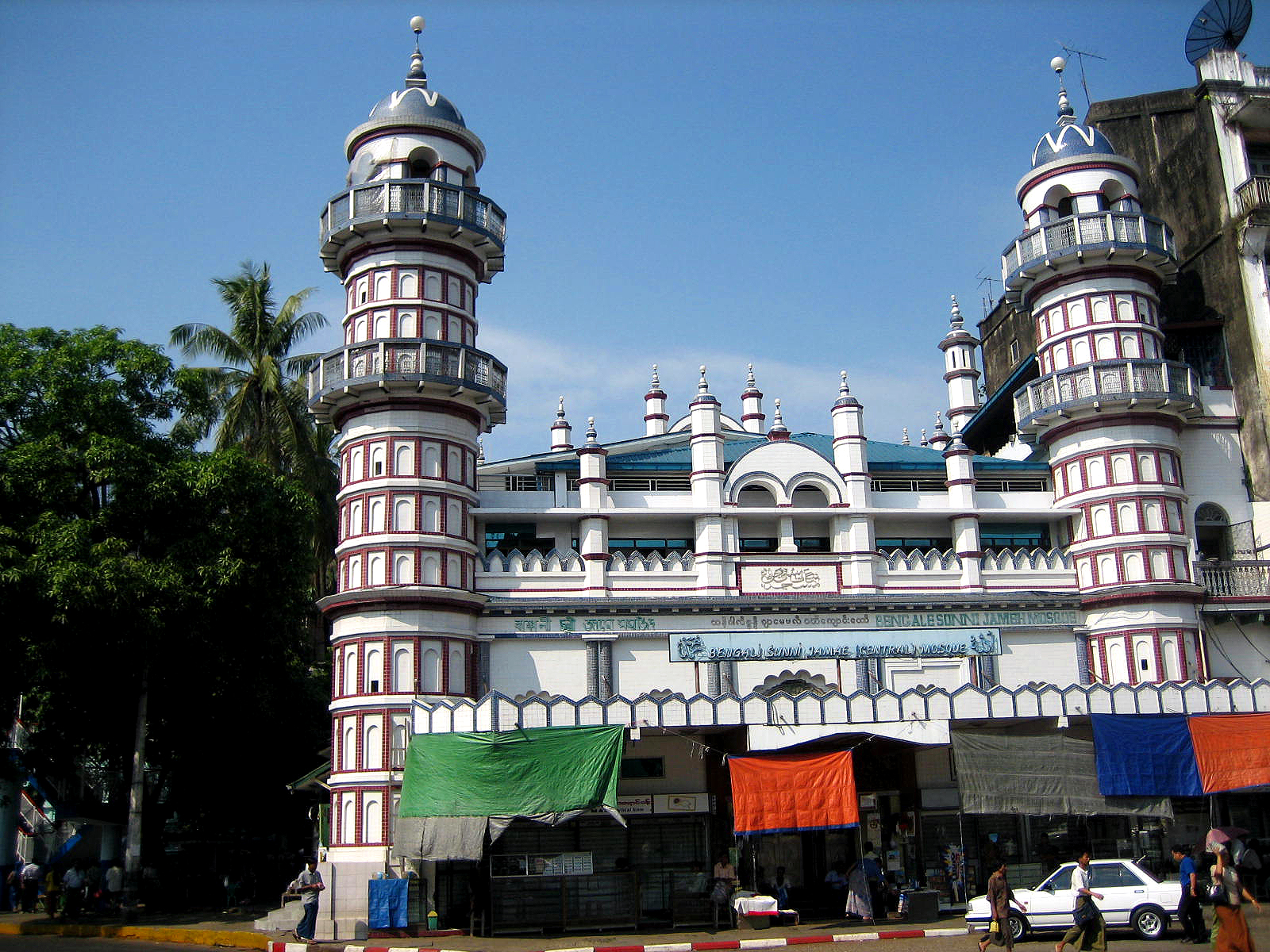
ARAKANESE or Rohingya Muslims are indigenous to Arakan. Having genealogical linkup with the people of Wesali (or Vesali kingdom) of Arakan, the Rohingya of today are ancient inhabitants in their land.
The earliest people in Arakan were descended from Aryans. They were resembling the people of India-Bengal. "The area now known as North Arakan had been for many years before the 8th century the seat of Hindu dynasties. In 788 A.D. a new dynasty, known as the Chandras, founded the city of Wesali; this city became a noted trade port to which as many as a thousand ships came annually; their territory extended as far north as Chittagong; Wesali was an easterly Hindu kingdom of Bengal following the Mahayanist form of Buddhism and that both government and people were Indian…..”[1]
The Burmese do not seem to have settled in Arakan until possibly as late as the tenth century AD. [2]
The Rakhines were the last significant group to come to Arakan. [3]
They appear to have been an advance guard of Burmans who began to cross the Arakan Yoma in ninth century. [4]
And they “could not be genealogically the same as to the people of Dannya Waddy and Wethali dynasties.” [5]
In old Burmese the name Rakhine first appeared in slave names in the inscriptions of 12th century. [6]
Dr. S.B. Kanango, said the name Rakhine was given by Burman and it was found in 12th to 15th century stone inscriptions of Tuparon, Sagaing. In early days not a single inscription was found in present day speaking Rakhine language. “The scripture of those early days found in Arakan indicate that they were in early Bengali script and thence the culture there also was Bengali.” [7]
Hence earlier dynasties are thought to have been Indians, ruling over a population similar to that of Bengal” [8]
But in medieval times there was a reorientation eastward; the area fell under Pagan’s dominance, and Arakanese people began to speak a dialect of Burmese, something that continues to this day. With Burmese influence came ties to Ceylon and the gradual prominence of Theravada Buddhism. [9]
Arabs were the earliest people to travel to the east by sea. They were in contact with Arakan even during the pre-Islamic days. The Arakanese first received the message of Islam from the ship wracked Arabs in 788 A.D. Such ship-wrecks were occurred over and over in the coasts of Arakan and Chittagong.
This Arab presence, with the message of Islam, made up the nucleus of Muslim society in Arakan. Thus, in Wesali the Arakanese practiced Hinduism, Buddhism (Mahayanist form), and Islam. The Burmese military regime affirmed in its official book Sasana Ronwas Htunzepho, published in 1997, “Islam spread and deeply rooted in Arakan since 8th century from where it further spread into interior Burma”. Meanwhile, “the Arab influence increased to such a large extent in Chittagong during mid-10th century AD that a small Muslim kingdom was established in this region, and the ruler of the kingdom was called Sultan. Possibly the area from the east bank of the Meghna River to the Naf was under this Sultan.” [10]
Islam developed slowly but surely in natural way. After the advent of Muslim rule in Bengal in 1203, the Muslim population of Arakan increased. Their number grew fast during the Mrauk-U dynasty. There was large scale conversion of Buddhists to Islam during 15th to 18th centuries. When the Dutch industrialists were ordered by the king to quit Arakan they were afraid of leaving behind their offspring through local wives for fear of their conversion to Islam. “It had been reported at Batavia that these children were being brought up as Muslims, and the pious Dutch Calvinists were extremely horrified” [11]
The relations between Arakan and Chittagong were based on historical, geo-political and ethnological considerations. “The Chittagong region was under the Vesali kingdom of Arakan during the 6th to 8th centuries and under the Mrauk U kingdom of Arakan in the 16th and 17th centuries.” [12] Because of the political, cultural and commercial links between those two territories, Arakan used to be called ‘extended Chittagong’ [13].
The 15th century was a great turning point in the history of Arakan. During this time a large contingent of Muslims entered Arakan from Bengal and they went there by invitation of the ruling princes. The cause was political. [14]
Here the history of Arakan intersects with the history of India and especially with Bengal. An age-old intercourse between Bengal and Arakan has left distinctive marks on various aspects of society, culture and administration of both countries. The Muslims were an integral part in the political entity of Arakan. They were rulers, administrators and kingmakers in Arakan for more than 350 years.
In 1430, after nearly three decades in exile in the Bengali Royal city of Gaur, king Narameikhla also known as Min Saw Mun (1404-1434) returned to Arakan at the head of a formidable force largely made up of Afghan adventurers, who swiftly overcame local oppositions and drove off the Burmans and Mons. This was the start of a new golden age for this country – a period of power and prosperity – and creation of a remarkably hybrid Buddhist- Islamic court, fusing tradition from Persia and India as well as the Buddhist worlds to the east. …This cosmopolitan court became great patrons of Bengali as well as Arakanese literature. Poet Dulat Qazi, author of the first Bengali romance, and Shah Alaol, who was considered the greatest of seventeenth-century Bengali poets, were among the eminent courtiers of Arakan. Mrauk-U kings adopted Muslim titles, appeared in Persian-inspired dress and the conical hats of Isfahan and Mughal Delhi, minted coins and medallions inscribing Kalimah (Islamic declaration of faith) in Persian and Arabic scripts, spoke several languages.
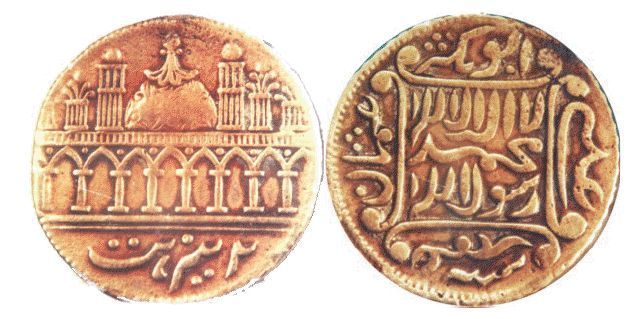
A coin from the Kingdom of Mrauk U with Persian inscriptions
It was Bengal King Sultan Jalal Uddin (1415-1433 AD) of Gaur, a Hindu convert Muslim who helped Rakhine King Narameit Hla with a strong Muslim force to restore him to his throne in Arakan. “Why Muslim army? Because there virtually was no Rakhaing of prime age left to be soldiers”. [15]
So, the Muslims were the backbone of the defence. “He (Narameikhla) spoke Persian, Hindi, and Bengali on the top of his mother tongue Rakhaing.” [16]
The Arakanese Kings nurtured sincere admiration towards the Muslim communities. “For this reason they entrusted the chief administrative posts of government department including that of the defence to the Muslims.” [17]
Burhanuddin, Ashraf Khan, Sri Bara Thakur were distinguished Lashkar Wazirs (Defence or War Ministers); Magan Thakur, Syyid Musa, Navaraj Majlis were efficient Prime Ministers; and Sayyid Muhammad Khan, Srimanta Sulaiman were capable ministers in Arakan. There were lots of other Muslim ministers, high civil and military officers. They contributed a great deal to the growth of Islamic culture in Arakan.
From 1430 to 1645, for a period of more than two hundred years, the Arakanese kings took Muslim titles and used Muslim names in their coins. They followed Muslim traditions and culture at home, even when there were no good relations with Muslim Bengal. Arakan was turned into a sultanate. Col. Ba Shin, the then Chairman of the Burma Historical Commission states, “Arakan was virtually ruled by Muslim from 1430 to 1531.” [18]
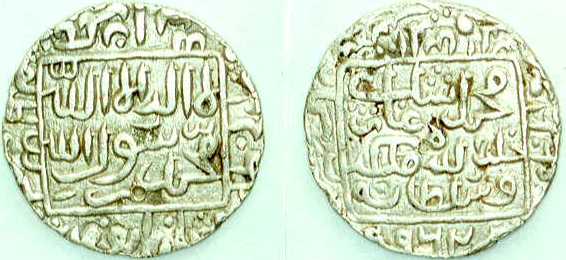
A coin from Arakan used in the Bengal Sultanate, minted 1554/5
It was depicted as an Islamic State in the map of The Times Complete History of the World, showing cultural division of Southeast Asia (distribution of major religions) in 1500. (Edited by Richard Overy, Eighth edition 2010, page 148.)
In accordance with the Muslim tradition like Gaur and Delhi, the whole kingdom of Arakan was provided with the sets of officials by the imperial order. The head of officials was known as Qazi. Some of them were prominent in the history of Arakan. They are Daulat Qazi, Sala Qazi, Gawa Qazi, Shuza Qazi, Abdul Karim, Muhammad Hussain, Osman, Abdul Jabbar, Abdul Gafur, Mohammed Yousuf, Rawsan Ali and Nur Mohammed etc.. [19]
Gradually a mixed Muslim society and culture developed and flourished around the capital. [20]
This practice was prevalent among the Arakanese kings till the first half of seventeenth century. This was because they not only wished to be thought of as sultans in their own rights, but also because there were Muslims in ever larger number among their subjects. A.P. Phayre observes that the practice of assuming Muslim name and inscribing Kalima in their coins was probably first introduced in fulfilment of the promise made by Mung-Somwun but was continued in later time as a token of sovereignty over Chittagong.[21] He also mentions that “These they assumed as being successorsof Musalman kings, or as being anxious to imitate the prevailing fashion of India.” [22]
Panditta U Oo Tha Aung (Rakhine), honorary archaeological officer of Mrauk-U Museum writes: “Arakan remained vassalage of Gaur until 1531 A.D. In the time of ninth Mrauk-U king, Zeleta Saw Mun, three missionaries, Kadir, Musa and Hanu Meah from the country of Rum Pasha (Delhi Empire) came to Arakan to propagate their religion, Islam. They built mosques all over the country and preached their religion among the people daily. Some people believed in their faith and it spread all over the country. People converted in groups. They gave gifts to the kings and he was very friendly with them. The preachers brought later other ministers from Delhi and Kadir built a mosque at Baung Due, Mrauk-U and other preachers, too, built such mosques through out the country. Their religion flourished much. [23]
By 17th century, the Muslims entered Arakan in a big way on four different occasions; the Arabs in course of their trading activities including the ship wracked ones; the Muslim army, actually two big contingents, in course of restoring the King Saw Mun to Arakanese throne; the captive Muslims carried by pirates in the 16th-17th centuries, and the family retinue of Shah Shuja in 1660 A.D. Of them the army contingents who entered into Arakan with the restored King Min Saw Mun were numerically very great; they also influenced the Arakanese society and culture in a great manner. In the 17th century Muslims thronged the capital Mrohaung and they were present in the miniature courts of ministers and other great Muslim officers of the kingdom.” [24]
According to court poet Shah Aloal, “The Muslim population of Arakan consisted roughly of four categories, namely, the Bengalee, other Indian, Afro-Asian and native. Among these four categories of the Muslims the Bengalee Muslims formed the largest part of the total Muslim population of Arakan. The inflow of the captive Muslims from Lower Bengal contributed much to the ever-increasing Bengalee Muslims in the Arakanese kingdom.” [25]
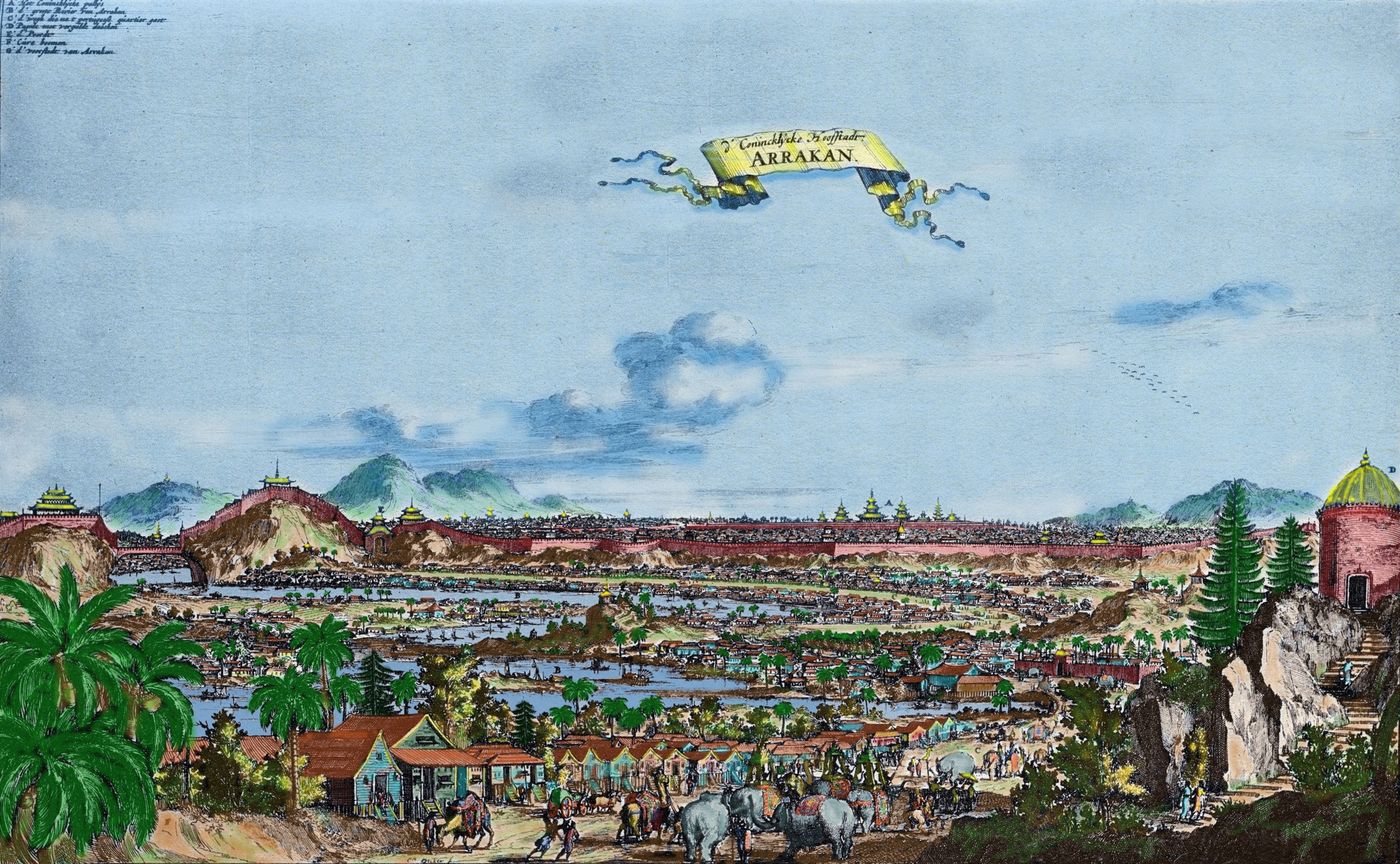
Set against the backdrop of the Arakan Mountains, Mark U was home to a multiethnic population, including the poet Alaol (wikimedia)
Thus the Rohingya with bona fide historical roots in the region have evolved with distinct ethnic characteristics in Arakan from peoples of different ethnical backgrounds over the past several centuries. Genealogically Rohingya are Indo-Aryan descendants. Genetically they are an ethnic mix of Bengalis, Indians, Moghuls, Pathans, Arabs, Persians, Turks, Moors and central Asians, and have developed a separate culture and a mixed language, which is absolutely unique to the region. “Dr. Swapna Bhattacharya called this mixed language “Rohingya Bengala” [26]
The picture of the Muslim influence on the King’s Court of Arakan portrayed in the Bengali literature has been presented below: [27]
“The Arakanese kings could not be free from the influence of the Muslim civilization, politics and culture, which is superior to theirs…They entrusted the chief administrative posts of the government departments including that of the defence to the Muslims. “Lashkar Uzir” or “War Secretary” Asharaf khan was King’s trusted favourite person. The King felt relieved by entrusting all statecraft to him. The Queen also considered him to be more “worth and profoundly learned” than her own son…In fact he ran the country and was the supreme authority.
Chief poets of the Roshang (Arakan) [when vacant] were not filled without the Muslims. The Muslims were without doubt skilled statesmanship. War Minister of Narapadigyi was Alaol’s first protector and Muslim, Magan Thakur’s father, “Sri Bara Takur”. During Sri Bara Takur’s lifetime, his son “Magan” was holding the post of a minister. King Narapadigyi trusted and loved Magan Thakur so much that, at the hour of his death he left his only daughter under Magan’s custody. When this prince became the principal queen of Tado Mintar, she entrusted the Roshang King’s Chief Minister to Magan Thakur realizing the guardianship she enjoyed in childhood.”
“After the death of Thado Mintar, when his son Sandha-thu-dhamma (1652-1684) ascended the throne he had not acquired the skill to run the country yet. Therefore, the minor King’s mother ruled as Regent by appointing Magan Thakur as the Chief Minister. After Magan Thakur, Solaiman – another Muslim – filled the position, that is, became the “Prime Minister” (chief counsellor/courtier of the highest rank) of Roshang King Sanda-thu-dhamma. The treasury and general administration of the country was entrusted to this Muslim Chief Minister. During Thanda-thu-dhamma’s rule the important posts of Roshang kingdom were given to the Muslims. Syed Muhammad was his “War Minister” (armed forces minister). Another Muslim named Majlis was “Navaraj” [Nawa-raja] was in the King’s Court. It seems that the civil and criminal courts were run by the Muslim Qazis [judges]. It is known that during that period a man by the name of Saud Shah was a Qazi of Roshang.”
Followings are some of the developments that reflect Muslim’s influence in Arakan particularly during the glorious period of Mrauk-U dynasty (1430-1784).
1.The Mrauk-U dynasty was a new golden age of power and prosperity with hybrid Buddhist-Islamic court, fusing tradition from Persia and India as well as the Buddhist worlds to the east.
- Muslim etiquettes and manners, system of administration copying the imperial courts of Delhi and Guar had been practiced. Taslim or Muslim solution was performed in the king’s palace.
- The Muslim played the phenomenal role of kingmakers with Muslim Prime Ministers, Lashkar Wizirs (Defence Ministers), and Ministers, Qadis, other administrators and large contingents of Muslim army.
- The kings had involuntarily as well as voluntarily to adopt Muslim names and titles “Shah” in addition to Buddhists names and titles. Mrauk-U kings appeared in Persian-inspired dress and the conical hats of Isfahan and Mughal Delhi.
- Some aristocratic Buddhists, including members of the royal families and class of persons enjoying superior intellectual or social or economic status also willingly adopted Muslim names.
- Muslim Qazi courts had been set up throughout the kingdom.
- Persian and Bengali languages were patronized and used as the official and court languages of Arakan.
- Coins and medallions had been struck and issued inscribing “Kalema”, the profession of faith in Islam in Arabic.
- The people followed the Muslim tradition at home. Buddhist women of those days practice “purdah” (hijab).
- Muslim missionary works hit the highest point. People converted into Islam in groups.
- Muslims were in the control of trade and business. They were also the main forces of agriculture. Particularly the alluvial rice-growing valleys of Kaladan River were populated by captives Muslims.
Notes:
[1] M.S. Collis, Arakan's place in the civilization of the Bay, Journal of the Burma Research Society, 50th Anniversary publications No.2, Rangoon, 1960, P. 486.
[2] D.G.E Hall, A history of South East Asia, New York, 1968, p.389.
[3] Towards Understanding Arakan History, unpublished.
In Pamela Gutman; Ancient Arakan, pp. 16-17
[4] Pamela Gutman, “Burma’s Lost Kingdom” Orchid Press, Bangkok, 2001, p.5.
[5] Towards Understanding Arakan History, unpublished in Chapter XIII
[6] Towards Understanding Arakan History, unpublished.
In Pamela Gutman; Ancient Arakan, pp. 16-17
[7] Towards Understanding Arakan History, unpublished in Chapter XIII
[8] D.G.E. Hall, A History of the South East Asia, New York, 1968, p.389.
[9] Thant Myint-U “River of Lost Footsteps”, Mackays of Chatham, plc, 2007, p. 72.
[10] “Arakanese Research Journal Vol. III” by Arakanese Research Society of Bangladesh . p. 8
In Arakan Rajsabhay Bangla Shitya.
[11]“Studies in Dutch Relation in Arakan”, Journal of the Burma Research Society, 50th Anniversary Publications No.2, Rangoon, 1960, p.86.
[12] Maurice Collis, “the land of the Great Image”, New York, Second Printing, p.135.
[13] “Arakan in Historical Perspective”, an article in Monthly Bulletin of Bangladesh Institute of Law and International Affairs, Vol.1, April, Number 4.
[14] Dr. Abdul Karim:“The Rohingyas – A short account of their history and culture, published by Arakan Historical Society (AHS), Chittagong, Bangladesh, 2000, pp. 14-15.
[15] Shwe Lu Maung, “The Price of Silence: Muslim-Buddhist War of Bangladesh and Myanmar, A Social Darwinist’s Analysis”, Dewdrop Arts and Technology, Columbia, Missouri, USA, p.173.
[16] Dr. Shwe Lu Maung, “The Price of Silence” Dew Drop Arts & Technology, USA, 2005 P.209.
[17] Ibid. p.11
[18] Ba Shin, “Coming of Islam to Burma 1700 AD”, A research paper presented at Azad Bhavan, New Delhi in 1961, p.4.
[19] Dr. Mohammed Ali Chowdhury: “Bengal-Arakan Relations: A Study in Historical Perspective”, Bangkok 23-25 November 200, p.6.
In Mahabubul Alam: “Chattagramer Itihas (Purana Amal) Chittagong, 1965, pp. 55-56.
[20] Ibid. p.6.
[21] Indians in Burmese History by Dr. Ko Ko Gyi (From Wikipedia, the free encyclopaedia, “Indians in Burmese History”). In A.P. Phayre, History of Burma 1853, p.78
[22] Ibid. In A.P. Phayre, Journal of the Asiatic Society of Bengal, 1846
[23] Panditta U Oo Tha Aung; great History of Arakan, p.74.
[24] Dr. Abdul Karim, “The Rohingyas: A Short account of their History and Culture”, published by Arakan Historical Society, Chittagong, 2000, pp 40-42c
[25] Dr. S.B. Qanungo, “A history of Chittagong” Vol.1, Signet Library, 1998, p.291.
[26] Dr. Swapna Bhattacharya, “Islam in Arakan: An Interpretation from the Indian Perspective” a paper submitted to Arakan Historical Conference held in Bangkok on 22-23 November 2005, p.20.
[27] “Arakanese Research Journal”, Vol. III, Arakanese Research Society of Bangladesh, Cox’s Bazar, July, 2005, pp. 11-17.
Source: Arakan Rohingya National Organization (ARNO), Arakan, Burma
Recent posts
-
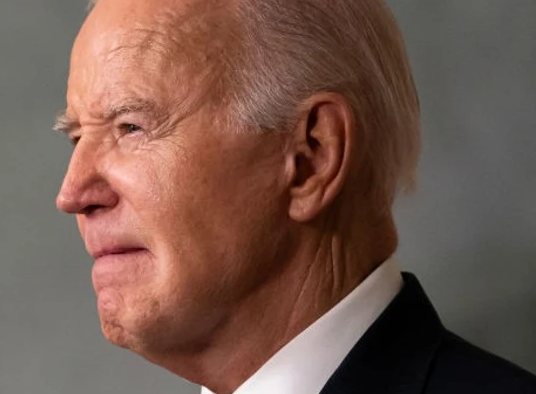
The Genocidal Legacy of Joe Biden
07 January 2025 -
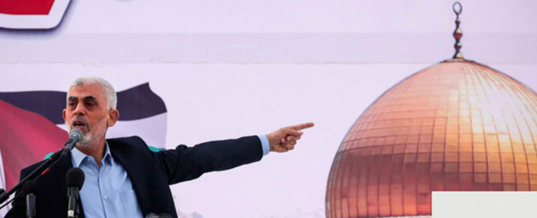
Yahyah Sinwar: Anti-Terrorist Hero
17 October 2024 -
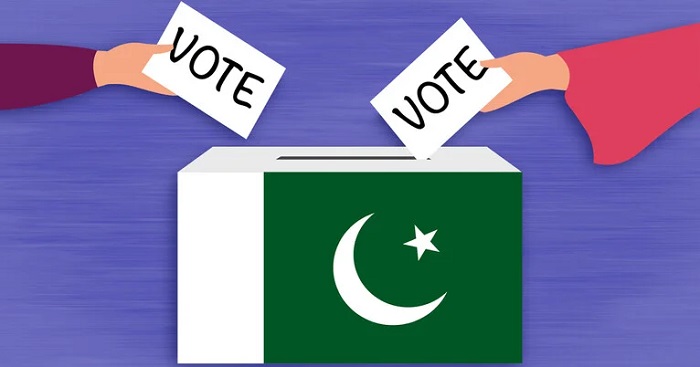
Pakistan: Things to Fix List
07 February 2024 -
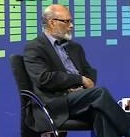
On the Importance of Politics
27 April 2023 -
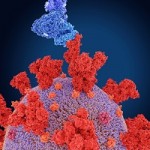
The Omicron Shame: Why is the World Punishing Instead of Helping Africa?
14 December 2021 -

Women's Right; India Vs Taliban
27 October 2021
